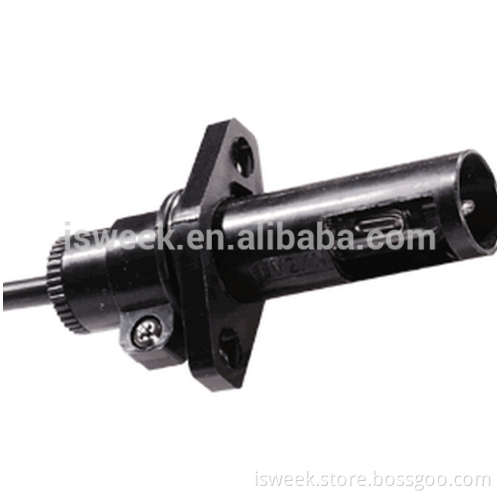
UV Phototubes Flame Sensor used for Flame Detection in Gas and Mixed Fuel (gas and oil) Burners
- Delivery Time:
- 7 Days
Quantity:
Your message must be between 20 to 2000 characters
Contact NowBasic Info
Basic Info
| Place of Origin: | Italy |
|---|
Product Description
Product Description
Flame Sensor used for Flame Detection in Gas and Mixed Fuel (gas and oil) Burners Model Number : UV1 / UV2 /UV3 INTRODUCTION
Flame detection in burners occurs by means of sensors
detecting the presence of flame through an electric signal
which can be used by ignition and control devices.
UV phototubes exploit the ultra-violet radiation emitted by
the light generated by the flame; they are especially
suitable for applications in which very dissimilar fuels (e.g.
liquid and gaseous fuels) are used.
FEATURES
These sensors are used for flame detection in gas and
mixed fuel (gas and oil) burners. UV phototubes consist of
a glass bulb filled with gas, containing two electrodes
suitably shaped. When supplying both electrodes with AC
voltage, if ultra-violet electromagnetic radiation (range from
190 to 290 nm) hits the phototube, the electrons emitted by
the negative biased electrode, and captured by the positive
biased one, start an ionization process leading to the
generation of an electric discharge and hence to the
production of electric current.
UV1, UV2 and UV3 are the available phototube models;
their features and dimensions are described hereunder. PHOTOTUBE TYPE UV1
Phototubes type UV1 are available with two different
sensitivity:
- Standard sensitivity
- /H : high sensitivity
The standard cable length is 655 mm, but versions with
longer cables are available. PHOTOTUBE TYPE UV2
Phototubes type UV2 are smaller than type UV1 (the
length and the diameter of the housing are smaller).
The standard cable length is 655 mm, but versions with
longer cables are available.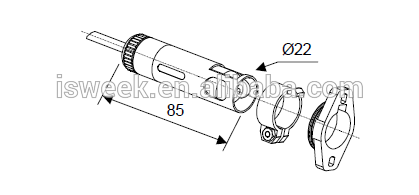 PHOTOTUBE TYPE UV3
PHOTOTUBE TYPE UV3
The length and the superficial treatment of the housing and
the side windows are the differences between models UV3
and UV1. The superficial treatment of the housing consists
of a chromium plating.
The UV3 phototube has no cable, which is supplied as an
accessory (see fig. 1).
Phototubes type UV3 are available with two different
sensitivity:
- Standard sensitivity
- /H : high sensitivity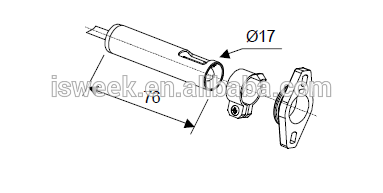 TECHNICAL DATA
TECHNICAL DATA
Nominal life time: 10.000 hours (*)
Maximum distance from UV source: 1 m
UV1-3 sensor temperature range: -20 ¸ +50 °C (*)
UV2 sensor temperature range: -20 ¸ +60 °C
(*) The UV1 and UV3 phototubes can operate also at a
temperature higher than + 50°C, but in this case th e
sensor life time will be shorter than the 10.000 hour
nominal life.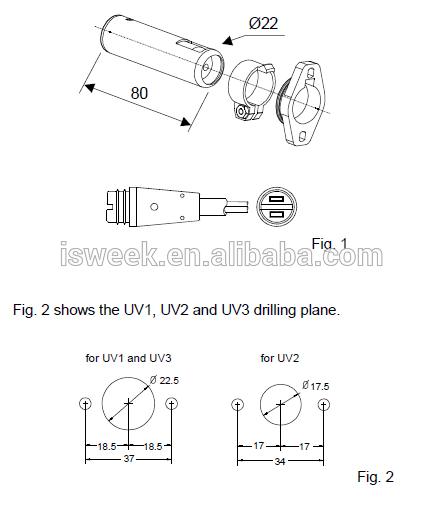

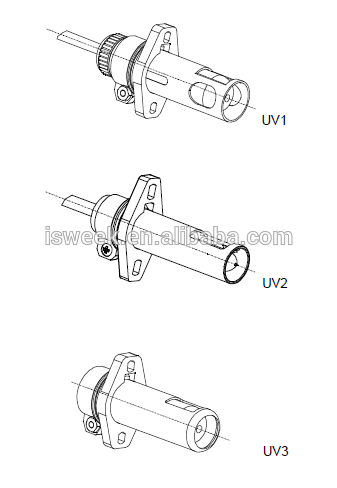 Contact :
Contact : 
Flame detection in burners occurs by means of sensors
detecting the presence of flame through an electric signal
which can be used by ignition and control devices.
UV phototubes exploit the ultra-violet radiation emitted by
the light generated by the flame; they are especially
suitable for applications in which very dissimilar fuels (e.g.
liquid and gaseous fuels) are used.
FEATURES
These sensors are used for flame detection in gas and
mixed fuel (gas and oil) burners. UV phototubes consist of
a glass bulb filled with gas, containing two electrodes
suitably shaped. When supplying both electrodes with AC
voltage, if ultra-violet electromagnetic radiation (range from
190 to 290 nm) hits the phototube, the electrons emitted by
the negative biased electrode, and captured by the positive
biased one, start an ionization process leading to the
generation of an electric discharge and hence to the
production of electric current.
UV1, UV2 and UV3 are the available phototube models;
their features and dimensions are described hereunder. PHOTOTUBE TYPE UV1
Phototubes type UV1 are available with two different
sensitivity:
- Standard sensitivity
- /H : high sensitivity
The standard cable length is 655 mm, but versions with
longer cables are available. PHOTOTUBE TYPE UV2
Phototubes type UV2 are smaller than type UV1 (the
length and the diameter of the housing are smaller).
The standard cable length is 655 mm, but versions with
longer cables are available.
 PHOTOTUBE TYPE UV3
PHOTOTUBE TYPE UV3The length and the superficial treatment of the housing and
the side windows are the differences between models UV3
and UV1. The superficial treatment of the housing consists
of a chromium plating.
The UV3 phototube has no cable, which is supplied as an
accessory (see fig. 1).
Phototubes type UV3 are available with two different
sensitivity:
- Standard sensitivity
- /H : high sensitivity
 TECHNICAL DATA
TECHNICAL DATANominal life time: 10.000 hours (*)
Maximum distance from UV source: 1 m
UV1-3 sensor temperature range: -20 ¸ +50 °C (*)
UV2 sensor temperature range: -20 ¸ +60 °C
(*) The UV1 and UV3 phototubes can operate also at a
temperature higher than + 50°C, but in this case th e
sensor life time will be shorter than the 10.000 hour
nominal life.


 Contact :
Contact : 
Related Keywords
Related Keywords
You May Also Like
You May Also Like









